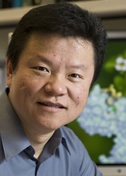An Affinity for Affinity…and Corals
John C. Williams
City of Hope
Published August 29, 2014
As a post-doc at Columbia University, John Williams and his wife-to-be wanted a pet. They ended up with the unlikeliest of companions. "We started a reef tank," says Williams.
Williams, now an associate professor of molecular medicine at City of Hope, noticed that all of his corals closed up when he cut one for propagation, a sign that the corals were releasing powerful chemicals. Having trained as a chemist, he recognized the potential for therapeutic leads in his aquarium, but his actual career — that of becoming a crystallographer with a yen for curing cancer — got in the way.
Williams studied solid state NMR with Ann McDermott as a chemistry graduate student at Columbia, then spent two years in the mid-1990s at the European Molecular Biology Lab in Heidelberg learning crystallography. He focused on the Src kinase, an important therapeutic target for cancer. Williams had just returned from Grenoble with fresh diffraction data for the protein when his advisor informed him that he’d been scooped.
Disappointed, Williams returned to Columbia for a second post-doc with biophysicist and crystallographer Wayne Hendrickson. Williams focused on dynein light chains, which were thought to bridge Fyn kinase and other cargo to the molecular motor dynein.
Williams solved the structure of TcTex-1, and then the complex of the dyenin intermediate chain and the light chains, showing that dynein light chains could not act as tethers. The work, which he continued in his own lab at Thomas Jefferson University, also led to Williams’ invention of “molecular traps,” which rapidly turn on and off certain functions in a cell by blocking or unblocking protein-protein interactions.
This invention hinged on an insight from the dynein structure plus his chemistry background that valancy can be manipulated to alter affinity. In collaboration with colleague Uli Rodeck, Williams also applied this insight to significantly improve the affinity of cetuximab, an anti-EGFR antibody used to treat colorectal and head-and-neck cancers.
However, higher affinity anti-cancer antibodies would also increase adverse side effects; they more effectively attack both the tumor and other tissues that express the same antigen. "I scratched my head, and it dawned on me that we could make a Trojan Horse," says Williams.
In 2008, in the midst of this work, Williams had the opportunity to relocate to City of Hope, a cancer center with a strong bent towards translational research. "It's a different mentality here," he says. "I have a real opportunity to tackle cancer."
At City of Hope, Williams identified a candidate peptide for creating masked antibodies, synthesized it and crystallized it in complex with cetuximab. But on initial inspection, the peptide wasn’t where it was supposed to be.
So Williams solved the structure and found it – "in a hole right in the middle of the Fab fragment," he says.
It turns out that every antibody Fab in the Protein Data Bank has a hole at its center. In mouse cetuximab, the residues lining the hole create a binding location for the peptide. Williams’ lab grafted these residues onto the human antibody and found that the peptide, which they call a meditope, binds only to the grafted antibody.
The pair forms a reliable hitch. "We can take any therapeutic antibody, make a couple of mutations, and it becomes meditope-enabled," he says. "A drug, imaging agent or other function can be fused to the meditope and snapped onto any meditope-enabled antibody."
Williams has patented the meditope technology and co-founded a company to build a plug-and-play system for designing novel antibody-drug conjugates. In his own lab, he is focused on improving the affinity of the meditope-Fab hitch, developing multivalent meditopes for imaging and drug delivery and beginning pre-clinical studies.
Incidentally, Williams' interest in corals has not waned. He recently helped form an effort between the Aquarium of the Pacific and City of Hope to begin a search for cancer cures in the potent chemicals produced by marine organisms. "Highly toxic marine natural products combined with tumor targeting antibodies is a promising avenue to improve cancer treatments," he says.
-- Elizabeth Dougherty





































































































































